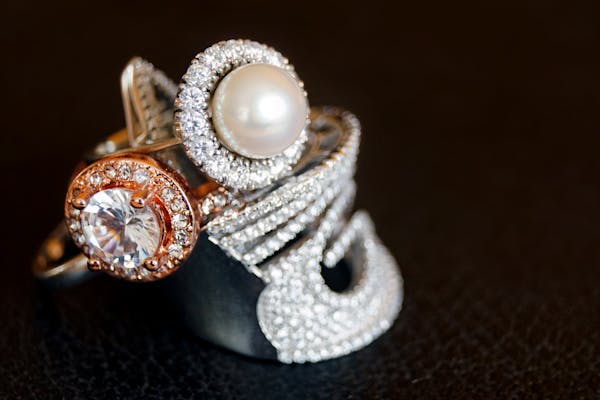Lifestyle
How To Create an Engagement Ring for an Active Lifestyle
Exchanging engagement rings is a very vital and precious moment in the lives of many individuals. This ring is much more than jewelry and…

Exchanging engagement rings is a very vital and precious moment in the lives of many individuals. This ring is much more than jewelry and represents love and memories that will be shared. If you are active, there are additional factors to consider when selecting or choosing an engagement ring, such as comfort and durability. Here is how to build an engagement ring that will endure like your love.
Material Matters
Durability is crucial when picking materials for the engagement rings of those who live actively. When considering the choice of bands, go for platinum or palladium because they are tough metals with high density. These metals are harder than gold and are not so prone to damage from normal wear and tear. However, 14k or 10k could be more durable if one fancies gold since they contain stronger alloy metals, unlike more pure ones like 18k.
Diamonds make good choices for gemstones because they cannot be scratched or cut owing to their extreme hardness (Moh’s Hardness Scale: 10). On the other hand, sapphires and rubies come quite close on Mohs scale at (9), thus acting as substitutes for diamond while imparting uniqueness into your ring.
Choosing the Right Setting
The setting on your engagement ring greatly determines its durability. A bezel setting encircles the stone with metal to protect its edges and hold it firmly in place. This is ideal for active individuals as it minimizes the risk of snagging and impact damage. A flush setting results in a sleeker and lower profile by embedding the stone into the ring’s band. This provides safety and less possibility of the rock getting caught on clothes or gear.
Choose a Modern Look
Intricate and complex designs may not be ideal for active individuals. Avoid ring damage by choosing a simple, streamlined design that can be easily cleaned and won’t catch on too many things. To balance functionality with personal style, go for a plain band with one stone or a basic pattern on top.
Consider Lifestyle and Activities
What activities do you do most of the time? Do you frequently handle equipments, climb rocks, swim, or engage in contact sports? It is essential to inform your jeweler about these activities when making your lab grown engagement ring. They will advise you on what designs, materials, and settings best suit such adventures.
Invest in Insurance and Regular Maintenance
Even the most durable pieces can be damaged by accidents and wear. That’s why it would be recommended to insure your engagement ring so you won’t have anxiety about losing it. Additionally, ensure the jewelers always examine your ring regularly. They can identify loose sets and minor damages before they turn into major problems.
The Final Word
Designing a diamond ring for the active lifestyle doesn’t imply that it should be less beautiful or important. You can have a gorgeous ring strong enough to withstand life’s adventures by choosing the appropriate materials, settings, and designs.
Note that the right engagement ring should align with the personality of its wearer and can last for a long time as they accompany them through their journey together.
Lifestyle
YouTuber Dashie Reflects on His Inspirational Weight Loss Journey
Charlie Guzman, best known as Dashie, is an American YouTuber whose comedy videos and gaming commentary videos have earned him over 5 million…


Charlie Guzman, best known as Dashie, is an American YouTuber whose comedy videos and gaming commentary videos have earned him over 5 million subscribers on his DashieGames channel.
He is best known for his hyperactive, loud, and funny commentary on games like Happy Wheels, Mortal Kombat, and Grand Theft Auto. He has worked on videos with other YouTubers like Jesse Wellens, T-Pindell, and the famous rapper Logic.
Dashie is also a talented musician who released 3022(UnOfficialMixtape) in October 2019.
The internet star further gained popularity when he shed 50 pounds of weight back in 2021. How did he do that? Have a look!
Dashie decided to lose weight for health reasons
In an interview with Tim Chantarangsu, the YouTuber revealed that his weight loss journey began when his doctor informed him that he had fat tissues growing into his liver.
Dashie did not like that sound and immediately thought of taking action. He mentioned that after he returned from the doctor, he threw all foods that were bad for his health from his fridge.
When the host brought up that Dashie was intermittent fasting, Dashie said, “so listen i have been on a diet for life 10 years.”
But he also shared that after losing a significant amount of weight, he got comfortable and started indulging, which led to extra weight gain.
The YouTuber mentioned, “The problem with me is, I lose like a good 20 pounds, I get comfortable again. I am like, ‘I look good’ and start eating bad again.”
“You get comfortable, and you kinda forget about it, then before you know, you gain back that 20 plus 10,” he shared his weight problem in the show.
He said that his ultimate weight loss journey began with a doctor-scare that got him thinking that he really has to lose some weight.
He has also uploaded a video on his YouTube channel where he explained how he lost 50 pounds of weight while playing a game after he got a lot of question about how he did it. The video is titled ‘HOW I LOST 50 POUNDS!’
Dashie later took to Instagram to let his fans know he has shared his experience by posting his transformed photo. The caption read, “About a week ago, I posted a video where I shared my routine and what I’ve been doing to lose weight/maintain.”
“I’ve gotten so many comments and messages about how much I’ve inspired people to do the same! That makes me so happy!”
He continued, “And also inspires me to keep going! I’ll be honest maintaining is NOT easy! But I figured if I post things like this every now and then, y’all can yell at me if I ever slip back! Lol, Thank you! And I’m here to support y’all too!!”
Dashie mentioned in one of his videos that he has ADHD
Dashie was born in the Dominican Republic and raised there until he was eight, when his family relocated to Florida. His Spanish skills helped him get his first job after graduating high school, according to Healthy Celeb.
He started working as a grocery store manager after changing jobs several times, including one at a Subway restaurant. In March 2006, while working there, he began posting YouTube videos.
He has shared in his videos that he has ADHD (Attention Deficit Hyperactivity Disorder). He also frequently advises young subscribers on his channel to avoid alcohol and drugs.
Lifestyle
What Do Women Like in a Man?
Understanding what women find attractive in a man can be a complex topic. It’s important to remember that each woman’s preferences will differ,…

Understanding what women find attractive in a man can be a complex topic. It’s important to remember that each woman’s preferences will differ, but there are some key attributes that many women value in a partner.
This article will delve into these characteristics, providing insights into what many women seek in a romantic partner.
Confidence That Doesn’t Cross the Line
One of the most attractive qualities to many women is a man who exudes confidence. A self-assured man is often seen as someone who knows his worth and isn’t afraid to show it. However, it’s essential to differentiate between healthy confidence and arrogance.
While a confident man is comfortable in his skin, an arrogant man may come across as self-absorbed or overly aggressive. A balance of humility and self-assurance is key to appealing to many women.
Emotional Intelligence: A Key Ingredient
In recent years, emotional intelligence (EI) has gained increasing attention as a crucial factor in successful relationships. Women often appreciate men who can empathize, understand their emotions, and communicate effectively.
A man with high emotional intelligence is more likely to be supportive, understanding, and emotionally available. Additionally, men who can express their feelings and navigate difficult conversations are often seen as strong and dependable partners.
A Touch of Chivalry
While modern society has made strides in gender equality, many women still appreciate chivalry. This doesn’t mean that men should adhere to outdated gender roles, but rather that small acts of kindness and respect can go a long way.
Holding the door open, offering a helping hand, or simply being polite and attentive can make a woman feel valued and cherished.
Authenticity: The Foundation of Trust
A man who is genuine and authentic is often highly attractive to women. In a world where social media can create a facade of perfection, authenticity is a breath of fresh air. Women often seek partners who are true to themselves, with a clear sense of identity and values.
This means being honest about one’s feelings, intentions, and desires without trying to be someone they’re not. Authenticity fosters trust and creates a solid foundation for a lasting relationship.
A Good Listener and Communicator
Listening and communication skills are essential in any relationship, and many women find these traits particularly attractive in a man.
A man who actively listens, asks questions and shows genuine interest in a woman’s thoughts and feelings demonstrates that he values her perspective. Good communication skills also entail being able to express one’s thoughts and feelings clearly and respectfully.
Shared Interests and Complementary Lifestyles
A strong relationship often relies on shared interests and lifestyles. While it’s not necessary for couples to have identical hobbies, having common ground can provide opportunities for bonding and create a sense of camaraderie.
Women might seek out men who share their passion for certain activities or who have complementary lifestyles, as this can facilitate a strong connection and a sense of unity within the relationship.
Ambition and Drive
Many women are attracted to men who are ambitious and driven. This doesn’t necessarily mean that they need to be a successful sugar daddy or be wealthy, but rather that they have clear goals and are motivated to achieve them.
A man with ambition and drive can be inspiring and demonstrate that he is committed to personal growth and self-improvement.
A Sense of Humor: Laughter is the Best Medicine
A sense of humor can be an irresistible trait for many women. Men who can make their partners laugh, whether through witty banter or self-deprecating humor, often create an enjoyable and relaxed atmosphere. Laughter can foster a strong emotional connection, as it demonstrates a shared sense of humor and helps couples navigate difficult times with levity.
Physical Attraction: The Cherry on Top
While physical attraction shouldn’t be the sole basis of a relationship, it’s undeniable that it plays a role in what women find appealing in a man. Physical attraction can vary significantly between individuals, and what one woman finds attractive might not be the same for another.
However, taking care of one’s appearance, dressing well, and maintaining personal hygiene can increase a man’s attractiveness in the eyes of many women.
Emotional Stability: A Pillar of Strength
Emotional stability is another characteristic that many women find attractive in a man. A man who is emotionally stable can provide a sense of security and support during challenging times. This doesn’t mean that men should suppress their emotions, but rather that they should be able to manage their feelings in a healthy and constructive manner. Emotional stability also encompasses the ability to remain calm and level-headed during stressful situations.
Resilience: Overcoming Life’s Challenges
Life is full of obstacles and challenges, and a resilient man is often attractive to women. Resilience means the ability to bounce back from setbacks and maintain a positive outlook on life.
A resilient man demonstrates that he can cope with adversity, learn from experiences, and grow stronger in the process. This quality can provide a sense of comfort and assurance to a woman, knowing that her partner will be able to navigate life’s ups and downs.
In conclusion, while individual preferences may vary, there are several key attributes that many women find attractive in a man. Confidence, emotional intelligence, authenticity, and a sense of humor are just a few of the characteristics that can make a man appealing to women.
By developing these qualities and striving for personal growth, men can increase their attractiveness and foster strong, lasting relationships.
Lifestyle
Tuner Lifestyle: Elevating the Car Enthusiast Experience
Tuner Lifestyle is more than just a brand, it’s a destination for car enthusiasts who want to celebrate their love for cars in style.Born from a…

Tuner Lifestyle is more than just a brand, it’s a destination for car enthusiasts who want to celebrate their love for cars in style.
Born from a small social media community in 2017, Tuner Lifestyle has since grown into a leading provider of high-quality merchandise for car enthusiasts everywhere.
With over 500,000 followers on Instagram and Facebook, Tuner Lifestyle has established itself as a go-to source for all things car-related.
-

 Relationship6 months ago
Relationship6 months agoMaggie Q’s Married Life — Meet ‘Ballard’ Star’s Husband and Kids
-

 Exclusive8 months ago
Exclusive8 months agoTay Dudley and His Wife, Kay Dudley, Recently Welcomed Their Daughter
-

 Entertainment8 months ago
Entertainment8 months agoLatest Updates on ‘Purple Hearts 2’ – Release Date, Cast Members, and Plot Details
-

 News8 months ago
News8 months agoTikTok Star Liana Jade and Boyfriend Connor Darlington Expecting Baby No. 2
-

 Actor6 months ago
Actor6 months agoMeet Jake Connelly From ‘Stranger Things’ — Know His Age, Parents, and Education
-

 Actress6 months ago
Actress6 months agoIs Rachel Brosnahan Jewish? Exploring Her Ethnicity and Family Life
-

 Lifestyle8 months ago
Lifestyle8 months agoWhat Environmental Benefits Do Lab-Grown Diamonds Offer
-

 Actor6 months ago
Actor6 months agoIs David Corenswet Gay? Exploring ‘Superman’ Star’s Sexuality
